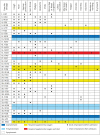Real Asymptomatic SARS-CoV-2 Infection Might Be Rare: Importance of Careful Interviews and Follow-up
- PMID: 32959547
- PMCID: PMC7505732
- DOI: 10.3346/jkms.2020.35.e333
Real Asymptomatic SARS-CoV-2 Infection Might Be Rare: Importance of Careful Interviews and Follow-up
Abstract
Background: There is limited information on the clinical characteristics of patients with coronavirus disease 2019 (COVID-19) who are asymptomatic or have mild symptoms.
Methods: We performed a retrospective case series of patients with COVID-19 enrolled from February 22 to March 26, 2020. Forty cases of COVID-19 were confirmed using real-time reverse-transcription polymerase chain reaction among patients who underwent screening tests and were consecutively hospitalized at Ulsan University Hospital, Ulsan, Korea. The final follow-up date was May 19, 2020. All COVID-19 cases in Ulsan were included. Demographic and epidemiological information, comorbidities, clinical signs and symptoms, laboratory and radiologic findings, medications, treatments, outcomes, and main durations of patients with COVID-19 were compared according to supplemental oxygen requirement.
Results: Forty patients were included (median age, 30 years; interquartile range [IQR], 25-57 years; 58% female). Six (15%) patients required supplemental oxygen. The prevalence of asymptomatic severe acute respiratory syndrome coronavirus-2 (SARS-CoV-2) infection was 5% and that of presymptomatic infection was 13%. Cough, fever, myalgia, rhinorrhea or nasal congestion, and diarrhea were the screening criteria for diagnosing symptomatic and presymptomatic SARS-CoV-2 infections. Sputum production, chest discomfort, a large number of symptoms, abnormal procalcitonin and C-reactive protein levels, and abnormal chest X-ray or chest computed tomography findings were more common in patients requiring supplemental oxygen than in those not requiring supplemental oxygen. Overall mortality rate was 3% (1/40). Four patients (10%) were readmitted after testing positive by reverse-transcription polymerase chain reaction again. Incubation period was 5 days (IQR, 4-6 days), and the duration of viral shedding was 21 days (IQR, 14-28 days; maximum, 51 days).
Conclusion: The prevalence of asymptomatic SARS-CoV-2 infection was 5%, which is much lower than that previously reported. This finding suggests that careful interviews and follow-ups should be performed to identify SARS-CoV-2 infections. Cough, fever, myalgia, rhinorrhea or nasal congestion, and diarrhea are adequate screening criteria for covering all symptoms of SARS-CoV-2 infection. Further evaluation is required to create representative screening criteria for COVID-19.
Keywords: Asymptomatic; COVID-19; Korea; Prevalence; SARS-CoV-2.
© 2020 The Korean Academy of Medical Sciences.
Conflict of interest statement
The authors have no potential conflicts of interest to disclose.
Figures
Similar articles
-
Clinical Characteristics and Outcome of Hospitalized COVID-19 Patients in a MERS-CoV Endemic Area.J Epidemiol Glob Health. 2020 Sep;10(3):214-221. doi: 10.2991/jegh.k.200806.002. J Epidemiol Glob Health. 2020. PMID: 32954712 Free PMC article.
-
Epidemiological and clinical characteristics of coronavirus disease (COVID-19) cases at a screening clinic during the early outbreak period: a single-centre study.J Med Microbiol. 2020 Aug;69(8):1114-1123. doi: 10.1099/jmm.0.001231. J Med Microbiol. 2020. PMID: 32783802 Free PMC article.
-
Presymptomatic SARS-CoV-2 Infections and Transmission in a Skilled Nursing Facility.N Engl J Med. 2020 May 28;382(22):2081-2090. doi: 10.1056/NEJMoa2008457. Epub 2020 Apr 24. N Engl J Med. 2020. PMID: 32329971 Free PMC article.
-
Pathophysiology, Transmission, Diagnosis, and Treatment of Coronavirus Disease 2019 (COVID-19): A Review.JAMA. 2020 Aug 25;324(8):782-793. doi: 10.1001/jama.2020.12839. JAMA. 2020. PMID: 32648899 Review.
-
Signs and symptoms to determine if a patient presenting in primary care or hospital outpatient settings has COVID-19 disease.Cochrane Database Syst Rev. 2020 Jul 7;7(7):CD013665. doi: 10.1002/14651858.CD013665. Cochrane Database Syst Rev. 2020. Update in: Cochrane Database Syst Rev. 2021 Feb 23;2:CD013665. doi: 10.1002/14651858.CD013665.pub2. PMID: 32633856 Free PMC article. Updated.
Cited by
-
Risk Factors of Outcomes of COVID-19 Patients in Korea: Focus on Early Symptoms.J Korean Med Sci. 2021 May 10;36(18):e132. doi: 10.3346/jkms.2021.36.e132. J Korean Med Sci. 2021. PMID: 33975399 Free PMC article.
-
SARS-CoV-2 Seroprevalence Structure of the Russian Population during the COVID-19 Pandemic.Viruses. 2021 Aug 19;13(8):1648. doi: 10.3390/v13081648. Viruses. 2021. PMID: 34452512 Free PMC article.
-
Asymptomatic SARS-CoV-2 infection: A systematic review and meta-analysis.Proc Natl Acad Sci U S A. 2021 Aug 24;118(34):e2109229118. doi: 10.1073/pnas.2109229118. Proc Natl Acad Sci U S A. 2021. PMID: 34376550 Free PMC article.
-
First cases of SARS-CoV-2 infection and secondary transmission in Kisumu, Kenya.PLOS Glob Public Health. 2022 Sep 8;2(9):e0000951. doi: 10.1371/journal.pgph.0000951. eCollection 2022. PLOS Glob Public Health. 2022. PMID: 36962806 Free PMC article.
-
Retrospective, Observational Studies for Estimating Vaccine Effects on the Secondary Attack Rate of SARS-CoV-2.Am J Epidemiol. 2023 Jun 2;192(6):1016-1028. doi: 10.1093/aje/kwad046. Am J Epidemiol. 2023. PMID: 36883907 Free PMC article.
References
-
- World Health Organization. Coronavirus disease (COVID-19): situation report-51. [Updated 2020]. [Accessed March 22, 2020]. https://www.who.int/docs/default-source/coronaviruse/situation-reports/2....
-
- World Health Organization. Coronavirus disease (COVID-19): situation report-61. [Updated 2020]. [Accessed July 12, 2020]. https://www.who.int/docs/default-source/coronaviruse/situation-reports/2....
MeSH terms
LinkOut - more resources
Full Text Sources
Research Materials
Miscellaneous


